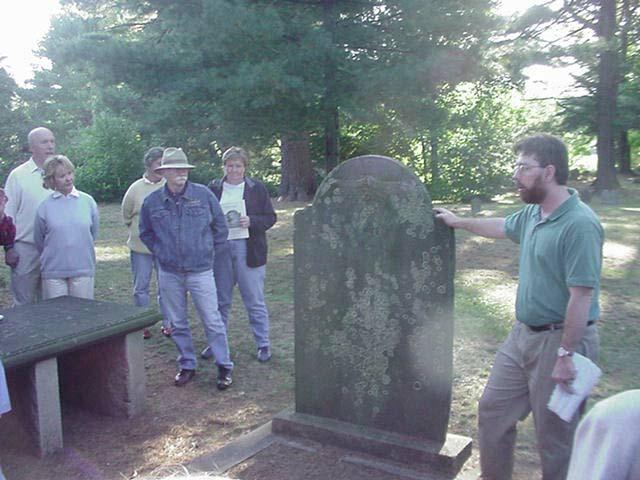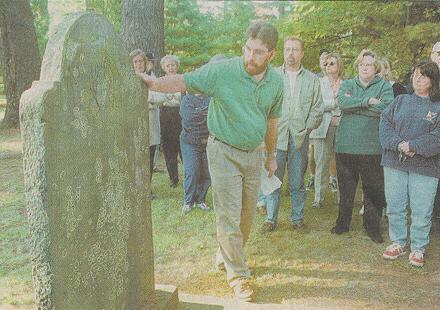By John Hirtle
Atlantic News, Thursday, October 5, 2000

HAMPTON -- One could easily say that it was a grave event as a large group of over a hundred souls gathered at the Pine Grove Cemetery on Sunday, October 1 to listen to Glenn Knoblock, author of Historical Burial Grounds of the New Hampshire Seacoast speak. The subject you might ask? Why graveyards of course.
Pine Grove Cemetery is among the oldest cemeteries in New Hampshire. While the oldest date of any stone marker places the cemetery's start in the 1690's, town records place a reference to it as early as January 1654, and undoubtedly, the cemetery dates back to the town's founding in 1638. After all, where you have people living, you generally find people dying.
The reason for the fifty year gap, as Mr. Knoblock observed, was due to the fact that prior to the 1690's, the early colonies simply did not have any skilled stonecrafters to create these tombstones. Unmarked “Wolf stones” -- large flat boulders-were placed over the dead to keep animals from getting at the bodies. Wooden markers may have been used as well, but time has taken their toll on them, leaving us with a collection of stones which reveal to us a regular who's who of Hampton's past.
While it is true that we are all equal in death,one's internment in Pine Grove Cemetery depended upon one's lot in life. The rich and popular got the prime plots in the front, while the poor were consigned to the back. As a result, you will find the largest tombstones, such as Reverend Ebenezer Thayer, who died suddenly in 1792, up front.. In his case, the impressive monolith was paid for by his grieving parishioners, and came from the “Boston School” a sort of upperclass group of tombstone artisans. In contrast, towards the back sits the lonely grave of James Lewis, a shipwrecked sailor from Barnstable who died in Hampton in 1773. Indeed, between the varied styles of artwork upon the stones created by the “Boston” or “Merrimack Valley” schools of gravestone artisans, one could say it was a quite lively discussion upon a rather dead subject.
As the group wound its way amidst their forebears admiring the symbolic art which dominated the semiliterate colonists. Weathered stones bearing images of hourglasses, hearts and winged skulls indicating one's mortality in this life, and hope for the afterlife, one could also see the toll time has taken on the grave markers. Footstones are missing, and headstones are slowly vanishing. Thanks to the efforts of Joshua MacDonald of Troop 177 in Hampton as part of his Boy Scout Eagle Project, he organized and compiled information about the Pine Grove Cemetery to provide future generations with a snapshot of what the cemetery looked like in 1999. A new booklet about the cemetery was published as a joint venture between Troop 177 and the Hampton Heritage Commission, which suggested the project.
Capping the project off with this was the tour, followed by dinner and a lecture upon cemeteries at the First Congregational Church.

[Atlantic News Photo by John Hirtle]
Walking Among The Dead
By Steve Jusseaume, Staff Writer
Hampton Union
Tuesday, October 3, 2000

Pine Grove Cemetery, Sunday, October 1, 2000.
Glenn A. Knoblock of Dover, whose book “Historic Burial Grounds of the New Hampshire Seacoast,” was published last year by Arcadia Publishing, took more than 100 people on a walking tour in Pine Grove Cemetery off Winnacunnet Road Sunday afternoon. And following a spaghetti supper at the 1st Congregational Church just down the road, he spoke further on the history of Pine Grove and the early settlers of Hampton.
The tour was sponsored by the Hampton Heritage Commission, the Hampton Historical Society, Scout Troop 177 and the Congregational Church.
Copies of Knoblock's book were on sale at the site, as were booklets on the history of the cemetery researched by Troop 177 Eagle Scout Joshua McDonald, as part of his Eagle Scout project.
Pine Grove (The Old Burying Ground) was more or less officially laid out in 1654 Town records in January of that year note that voters approved enclosing the burying ground with a rail fence. It appears clear that the area was already in use for burials and probably had been since the settlement of the town in 1639.
Knoblock's talk included notes on the family names in the cemetery, on the carvers who made the stones, and on various styles of gravestones, from the Boston style to the Merrimack Valley style to more individual styles by local stone carvers.
“This is the oldest town cemetery in New Hampshire that I've been able to document,” Knoblock said, noting that prior to the establishment of a public cemetery, people most likely buried their family members on their own property.
Pine Grove, Knoblock added, is very well preserved, in part because the canopy of pine trees that dot the cemetery tend to protect the stones from harsh weather.
He said cemeteries like Pine Grove were not “scary” places; rather, they were laid out close to the center of the village and might have been a place of contemplation, “more of a part almost.” Because they were generally laid out in the middle of the town, people would regularly pass through them every day when visiting the village on business.
People buried in Pine Grove include some of early Hampton's most prominent families, including Dearborn, Cotton, Gookin, Lane, Leavitt, Moulton, Marston, Palmer, and Towle.
During the walk, Knoblock often linked the stones with the style in which they were carved. He pointed out the stone of Henry Dearborn, who died in 1756. Dearborn's stone, with its unusual angel, was carved by Jonathan Leighton, Knoblock said, who carved in the style of the Merrimack Valley stone carvers. He noted that Dearborn was a selectman in Hampton and reportedly “fell dead in the road” on April 26, 1756.
The Merrimack Valley style of stone carving was popular here because Hampton settlers traded often with those from the Merrimack Valley, in Massachusetts, Knoblock said. Some Merrimack Valley stones included a round cherub face, with rays coming out, representing a minister's collar.
At the southeast corner, stones mark the graves of the Moultons and Lampreys. Molly Lamprey's stone is smaller than the others. Molly died at 7 months old, and her diminutive stone denotes her young age. Child deaths “were typically accorded a smaller grave stone,” Knoblock said.
One of the largest stones in Pine Grove is one noting Rev. Ebenezer Thayer's passing. Thayer's stone includes a low-brow angel's face at the top, signifying the Boston style of carving. Thayer was a prominent minister, and his five-foot high stone reflects his importance in the settlement. “Rev. Thayer was a very plain, practical minister,” Knoblock said. “His widow was allowed to stay on in the parsonage after his death, which was unusual. Most of the time when a minister died his wife had to move on.”
He added, however, that Thayer did not endear himself to the townspeople when he tried to introduce printed music into the church, as opposed to the general custom of the minister chanting the words and the congregation following.
Knoblock could not say how much Thayer's stone might have cost in 1792, when he died. Roger Syphers, who attended the tour and owns Syphers Monument Company, said though that a large stone like Thayer's might have cost $800, which was a lot of money at the time. Today, Syphers added, such a stone would cost in the neighborhood of $6,000.
Knoblock noted that stones were made of either slate, which could last a very long time, or sandstone, which was porous and would lose their clarity in the wording and design rather quickly.
He also said that in most cemeteries of the period, the more prominent people were buried toward the front of the cemetery, while the rear of the area was reserved for lower class people, like the poor of the town and, perhaps, free blacks and slaves.
